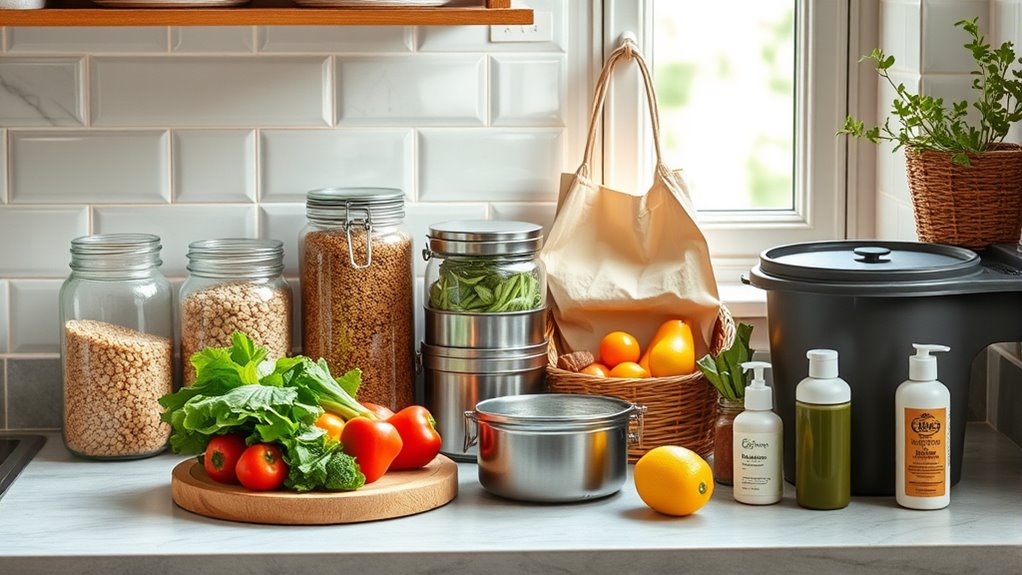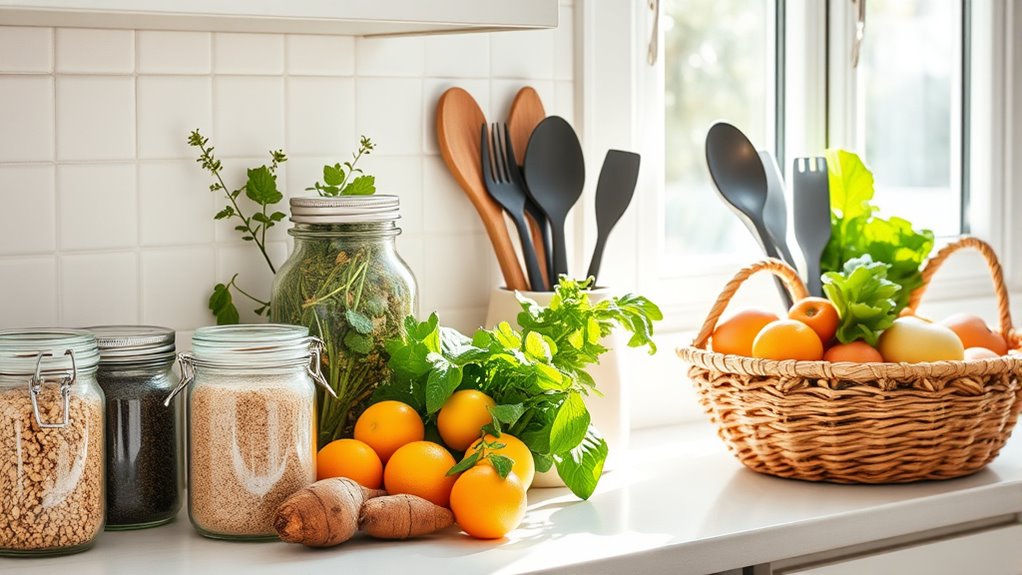Switching to reusable storage containers and starting simple composting can cut waste and save you money right away. Swap disposable plastic bags for glass or BPA-free plastic ones that last longer and keep food fresher. Collect food scraps like vegetable peels and coffee grounds for composting to reduce trash and boost your garden. These small, easy changes add up quickly, helping you save money while making a positive environmental impact—there’s plenty more to explore!
Key Takeaways
- Swap disposable plastic bags for reusable cloth or silicone bags to reduce ongoing costs.
- Use glass or BPA-free containers for storage, prolonging food freshness and decreasing purchase frequency.
- Compost food scraps and yard waste to cut waste disposal costs and enrich garden soil naturally.
- Choose durable, microwave, and dishwasher-safe containers that last longer, saving money over time.
- Implement meal planning and leftovers management to minimize food waste and reduce grocery expenses.

Ever wondered how small changes in your kitchen can make a big difference for the environment? It’s easier than you think to swap out single-use items for sustainable alternatives that save you money right away. One of the simplest and most effective swaps is switching to reusable storage containers instead of disposable plastic bags and wrap. Not only do these help cut down on waste, but they also keep your food fresher longer, reducing spoilage and saving you trips to the store. Glass or BPA-free plastic containers are durable choices that pay for themselves over time, especially when you plan your meals and leftovers wisely. When shopping for reusable storage, look for options that are microwave and dishwasher safe, making cleanup and reheating hassle-free. These small investments can considerably cut your reliance on disposable plastics, which often end up in landfills or the ocean. Incorporating proper waste management practices ensures your efforts contribute more effectively to reducing your overall environmental impact.
Another major way to embrace zero waste is by incorporating composting tips into your routine. Composting turns food scraps and yard waste into nutrient-rich soil, which you can use in your garden or potted plants. Most people think composting is complicated, but it’s actually straightforward once you understand the basics. Start by collecting fruit and vegetable scraps, coffee grounds, eggshells, and yard waste in a designated compost bin. Keep the bin in a convenient spot and turn it regularly to aerate the mixture. This process speeds up decomposition and reduces odors. Composting not only minimizes your trash but also decreases the greenhouse gases produced by organic waste in landfills. Plus, it’s an inexpensive way to improve your garden’s health without buying commercial fertilizers. By making composting a regular habit, you’ll see how much food waste you can divert from the trash, saving you money on fertilizer and reducing your overall waste footprint.
Making these swaps is about more than just the environment—it’s about saving money, too. Reusable storage reduces the need for constantly buying disposable containers or plastic wrap, and composting tips help you cut down on fertilizer costs while reducing waste. Both practices encourage you to be more mindful of what you toss away and how you can reuse or repurpose materials. Small changes like these add up quickly, and before long, you’ll notice a considerably reduction in your waste bill. Plus, you’ll feel good knowing you’re contributing to a healthier planet. So, start exploring reusable storage options and learn some simple composting tips today. Not only will you make your kitchen more eco-friendly, but you’ll also see the financial benefits immediately.
Frequently Asked Questions
How Do Zero-Waste Swaps Impact Overall Kitchen Budget?
Your overall kitchen budget benefits from zero-waste swaps by reducing waste disposal costs and cutting down on single-use items. As you improve your recycling habits and adopt composting methods, you’ll save money and minimize waste. These adjustments lead to fewer purchases of packaging and disposable products, making your kitchen more cost-effective while supporting sustainability. Over time, these small changes can markedly lower your expenses and environmental impact.
Are Zero-Waste Kitchen Swaps Suitable for Large Families?
Large families can definitely benefit from zero-waste kitchen swaps, especially when you incorporate family meal planning. Using bulk purchasing strategies helps you buy in bigger quantities, reducing waste and costs. Swapping single-use items for reusable ones also saves money over time. With some planning, you’ll find these swaps practical and cost-effective, making your kitchen more sustainable while managing your family’s needs efficiently.
What Are the Best Zero-Waste Alternatives for Plastic Wrap?
You can replace plastic wrap with eco-friendly options like Bee’s wax wraps or silicone stretch wraps. Bee’s wax wraps mold around your food and are reusable, saving you money and reducing waste. Silicone stretch wraps are flexible, durable, and also reusable, making them perfect for covering bowls or wrapping leftovers. These alternatives are simple swaps that help you cut down on plastic waste while keeping your food fresh.
How Long Do Zero-Waste Kitchen Swaps Typically Last?
Zero-waste kitchen swaps generally last quite a while, depending on shelf life and storage methods. For example, beeswax wraps can last up to a year with proper care, while silicone lids and reusable bags may last several years. You should regularly clean and store them correctly to extend their lifespan. With good maintenance, these eco-friendly options save you money and reduce waste over many months or years.
Can Zero-Waste Swaps Replace All Traditional Kitchen Products?
You might wonder if zero-waste swaps can fully replace traditional kitchen products. While recyclable packaging and compostable utensils are great alternatives, they may not cover every need yet. Some items, like certain cleaning supplies or specialized tools, still require conventional options. However, gradually, you can reduce reliance on plastic and waste by integrating more eco-friendly choices, making your kitchen more sustainable without sacrificing functionality.
Conclusion
By making these zero-waste swaps, you’re planting seeds for a greener future in your kitchen. Each change is like adding a drop of water to a vast ocean—small but powerful. Over time, these simple shifts will ripple outward, transforming your habits and saving you money. Embrace these swaps as your toolkit for a more sustainable, mindful life. Together, you’re turning your kitchen into a flourishing garden of waste-free abundance.









